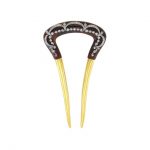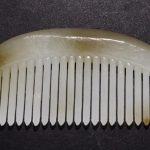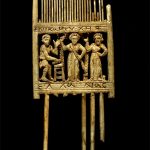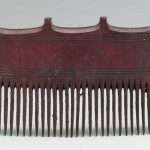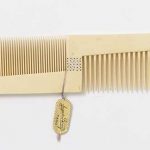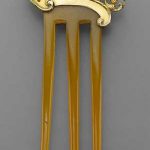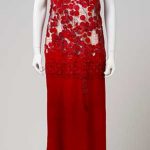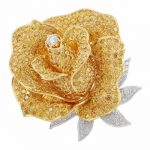Combs. A comb is a tool consisting of a shaft that holds a row of teeth for pulling through the hair to clean, untangle, or style it. Combs have been used since prehistoric times, having been discovered in very refined forms from settlements dating back to 5,000 years ago in Africa.
Combs can be used for many purposes. Historically, their main purpose was securing long hair in place, decorating the hair, matting sections of hair for dreadlocks, or keeping a kippah or skullcap in place. In Spain, a peineta is a large decorative comb used to keep a mantilla in place. Reference: Wikipedia
Belle Époque Tortoise Shell, Platinum, Diamond and Silver-Gilt Comb Old-mine & rose-cut diamonds, c. 1915. Length 3 11/16 inches.
Sold for $1,375 (includes buyer’s premium) at Doyle New York in 2019
A HETIAN JADE COMB
Time: Qing Dynasty 17-19 Century / Weight 57g / Length 3.94 in / Width 2.17 in / Thickness 0.24 in
Sold for $1,200 at Empire Auction House, Inc. in 2019
Despite its many missing teeth, this comb has retained its full value by virtue of its central scene, still virtually intact. It features three figures, with a Greek inscription above and below, together depicting a dance or poetry competition. A comb of great antiquity This comb is carved from elephant ivory. Two rows of teeth flank the central rectangle: an extremely fine-toothed comb in the upper half, with larger and more widely spaced teeth in the lower half. Many teeth are missing in both parts, particularly the lower one. Some have been glued back in place. The enigmatic figures of the decorative scene A Greek inscription runs along the upper and lower sections of the central spine, following incised lines in the decoration. In the center are three figures, rendered in an open-work design that emphasizes the sculpted appearance of the object as a whole. The central figure is a woman dressed in a long robe with braids and medallions and wearing a headband. She is depicted in front of an architectural structure consisting of an arch resting on two cabled columns. She wears a shoulder strap and in her raised right hand seems to be holding a crown, the upper part of which forms part of the border. To the right, another woman stands in the same pose, but without the shoulder strap or the crown. To the left, a man dressed in a tunic is shown either picking up or setting down a scroll placed on a small stool in front of him. He seems to be making a sign of greeting to the central figure with his left hand. Note that only his right foot has a sandal with straps, while his left foot is bare – perhaps an oversight on the part of the artist. An invocation to fortune The composition of the scene suggests that the central figure is the principal subject, and that the figures flanking her are paying tribute to her in one form or another. This is confirmed by the Greek inscription: “Long live Helladia’s fortune and the Blues! Amen!” This invocation to fortune and to the Blues indicates that the object relates to a literary competition, or else to a mime or pantomime performance. An actress named Helladia is therefore probably the central figure on the comb. Having won the competition, she probably had the Greek inscription added to immortalize this important event in her life. In general, ivories such as this one, depicting victories in competitions, date from the 5th or 6th centuries.
Christian Egypt (fourth – twelfth centuries AD)
Reference:The Louvre
Comb ca. 1550–1458 B.C. This beautifully preserved comb has three neatly carved shallow indentations at the top to allow the fingers a secure grip. The flat area between the undulated top and the comb’s teeth is embellished with groups of perfectly straight incised, parallel lines. The comb does not show wear and thus cannot have been used for long, if at all, before it was deposited in the burial for use in the next world. The comb was excavated by the Earl of Carnarvon and Howard Carter in the Lower Assasif area of the Theban necropolis on the west bank of the Nile opposite modern Luxor. It was acquired by Carnarvon in the division of finds with the Egyptian Antiquities Service.
Reference: The Metropolitan Museum of Art
Comb, decorative square of diamantes, made by Auguste Bonaz, made in France, 1950
Reference: Museum of Applied Art and Sciences
Hair comb featuring a profile dragon on a wave American about 1910
This ornament is composed of a hair comb It is surmounted by an ornamental gold dragon on a stylized wave. There is a small, faceted, bezel-set emerald on the dragon’s wing and a small bezel-set, cabochon ruby set in the eye. A pearl highlights the beast’s open mouth. The tip of the middle tooth is broken. The ornament is unmarked but resembles similar pieces made by Krementz & Co., Newark.
Reference: Milwaukee Public Museum
[geolocator_show for=”GB”][ebayfeedsforwordpress feed=”http://rest.ebay.com/epn/v1/find/item.rss?keyword=comb&categoryId1=175759&sortOrder=BestMatch&programid=15&campaignid=5338620288&toolid=10039&customid=pastimefashions-rss-uk-combs&minPrice=50.0&listingType1=All&feedType=rss&lgeo=1″ items=”20″][/geolocator_show]
[geolocator_hide for=”GB”][ebayfeedsforwordpress feed=”http://rest.ebay.com/epn/v1/find/item.rss?keyword=comb&categoryId1=175759&sortOrder=BestMatch&programid=1&campaignid=5338620289&toolid=10039&customid=pastimefashions-rss-us-combs&minPrice=50.0&listingType1=All&feedType=rss&lgeo=1″ items=”20″][/geolocator_hide]
